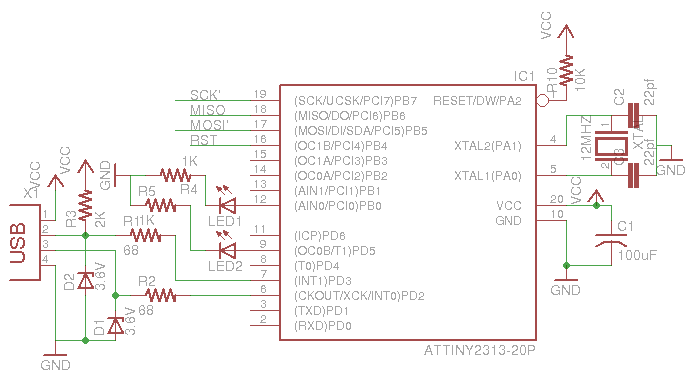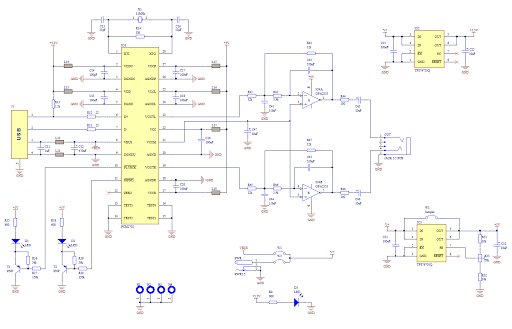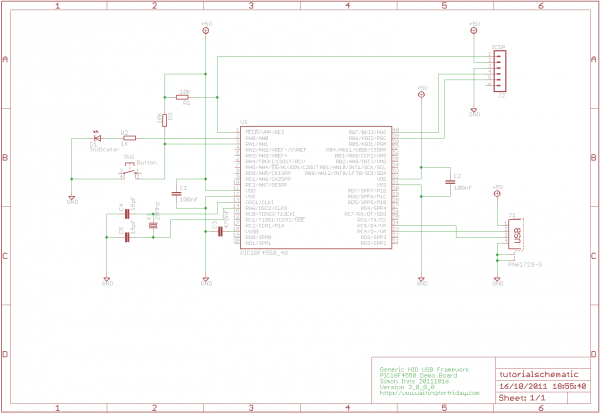
usb only sc1

The modification made is based on the SC1 modification by Steve Chambers and further improvements by Phil Davis, but it does not utilize the additional parallel port connection. All differences from the original SC1 modification and Phil's improvement are considered intellectual property. Information from this homepage can only be used for non-commercial purposes. The sale of this information or modified webcams according to these instructions is strictly prohibited. There is no guarantee that this modification will work with the Philips ToUcam Pro 840k, nor is there any responsibility taken if the webcam, PC, or any related equipment malfunctions after applying this modification. The original SC1 modification requires an additional parallel port connection to the PC for remote control of the exposure time of the Philips ToUcam Pro 840k. The webcam must be connected to the USB port, and the additional cable to the LPT port of the PC. A method has been developed to control the exposure time using only the USB cable, eliminating the need for the parallel port cable. This modification achieves the same result as the SC1 modification: it blocks the charge transfer pulses from the Philips SAA8116HL to the NEC PD16510 driver and disables the shutter. The circuit for disabling the shutter pulses differs slightly from the original SC1 modification due to the absence of a change-over switch in the lab; only an ON-OFF switch was available. Pin 10 of the PD16510 is permanently tied to high (3.3V) via R1, and the output pin 97 of the SAA8116HL can drive it low when S1 is closed. This modification benefits from a two-wire connection to the switch instead of three wires. The Philips processor SAA8116HL has an undocumented feature: as indicated in the datasheet (Fig. 3), it includes a "mode decoder" with two inputs (REERVED2 and RESERVED3) and one output (RESERVED1). Although the purpose of these inputs is unclear, it was discovered that RESERVED1 is the output of the programmable gain amplifier (PGA). The webcam has a built-in microphone that enumerates as a standard USB microphone to the USB host with PGA capabilities. By adjusting the volume slider of the microphone on the PC, the gain of the PGA can be controlled. The programmable audio gain amplifier unit in Fig. 3 receives this volume slider information and adjusts its internal gain accordingly. In Fig. 2, the input to pin 61 of the SAA8116HL has been changed from the built-in microphone to another signal, which serves as a constant input to the audio low noise amplifier, allowing control of the amplification via the volume slider. This results in nearly no signal at pin 64 when the slider is at the minimum position and a square-wave signal when the slider is at the maximum position. The signal at pin 64 is utilized as a clock for the first monostable multivibrator, which produces a permanent low signal on its output when the slider is at its minimum position and a permanent high signal when the slider is at the maximum position. The output signal from the first multivibrator serves as the reset input for the second multivibrator, which generates the transfer pulses or remains inactive depending on the volume slider position. Both monostable multivibrators are integrated within a single IC package. The 74HC423 in an SO16 package is selected for minimal size modifications, although a DIP16 package may be used if soldering skills are limited. In this case, alternative space must be found for the DIP16, as it is twice the size of the SO16. Initially, all resistors and capacitors must be soldered to IC1 (74HC423). The bottom side of IC1 must be inspected to ensure that the resistor and capacitor (R2 and C2) are connected to pin 15. Pins 2 and 3 should be bent towards each other and soldered together.
The circuit modification focuses on enhancing the control of the Philips ToUcam Pro 840k webcam's exposure time using a simplified connection method via USB, eliminating the need for a parallel port. The core of the modification lies in the manipulation of the signals from the SAA8116HL processor to the PD16510 driver. By blocking charge transfer pulses and modifying the shutter control circuit, the exposure time can be adjusted without the complexity of additional wiring. The use of the 74HC423 monostable multivibrator IC allows for the generation of control signals based on audio input from the microphone, effectively repurposing the microphone's volume control functionality to manage the webcam's exposure settings.
The integration of the PGA's output into the control logic provides a novel approach to signal processing within the webcam, allowing for dynamic adjustments based on user input through the PC's audio settings. This modification not only streamlines the hardware requirements but also offers a unique method of interfacing with the webcam's internal circuitry, showcasing the versatility and potential of USB-based control systems in consumer electronics. The careful design considerations ensure that the modification remains compact and efficient, while also maintaining the integrity of the webcam's original functionality.The modification I`ve made is based on Steve Chambers SC1 modification and the further improvement by Phil Davis, but does not use the additional parallel port connection. I consider all differences from the original SC1 modification and Phil`s improvement as my intellectual property.
Information from this homepage can be used only for noncommerc ial purposes. I strictly forbid to sell this information or webcams modified according to this instructions. I do not guarantee that this modification will work with your Philips ToUcam Pro 840k, nor do I take over any responsibilites if your webcam, PC or any other related equipment is not working anymore after you`ve carried out this modification. The original SC1 modification uses an additional parallel port connection to the PC to remote control the exposure time of the Philips ToUcam Pro 840k.
You have to attach the webcam to the USB-port and the additional cable to the LPT-port of your PC. I figured out a way how you can remote control the exposure time with the USB cable only. You don`t need this parallel port cable anymore. As mentioned above, this modification does the same thing like the well known SC1 modification: it blocks the charge transfer pulses from the Philips SAA8116HL to the NEC PD16510 driver and disables the shutter. The circuit for disabling the shutter pulses looks slightly different than the one from the original SC1 mod.
The reason why I`ve done this change is not very exiting: I had no change-over-switch in my lab, only an ON-OFF switch. So I tied pin 10 of PD16510 permanently to high (3, 3V) via R1 and the output pin 97 of SAA8116HL can drive it low if S1 is closed.
The benefit is a two wire connection to the switch instead of 3 wires. The Philips processor SAA8116HL has an undocumented feature. As you can see in the screenshot of the datasheet (Fig. 3) the processor has a "mode decoder" with two inputs (named RESERVED2 and RESERVED3) and one output (RESERVED1). I couldn`t figure out what these inputs are good for, but I discovered that RESERVED1 is the output of the PGA (programmable gain amplifier).
The webcam has a built in microphone which enumerates as standard USB-microphone to the USB-host with PGA capabilities. By moving the volume slider of the microphone on the PC, you can remote control the gain of the PGA. The PROGRAMMABLE AUDIO GAIN AMPLIFIER unit in Fig. 3 receives this volume slider information and sets it`s internal gain accordingly. As you can see in Fig. 2, I`ve changed the input to pin 61 of the SAA8116HL from the built in microphone to another signal. I use this signal as constant input to the AUDIO LOW NOISE AMPLIFIER and can control the amplification of this signal via the volume slider.
Thus I get nearly no signal at pin 64 when the slider is at the minimum position and a square-wave signal when the slider is at the maximum position. This signal at pin 64 is used as clock for the first monostable multivibrator, which produces a permanent LOW signal on its output when the slider is at it`s minimum position and a permanent HIGH signal when the slider is at the maximum position.
This output signal of the 1st multivibrator is used as reset input for the 2nd multivibrator, which creates the transfer pulses or simply does nothing depending on the volume slider position. Both monostable multivibrators are located in one IC-package. I decided to use the 74HC423 in an SO16 package, because I wanted to get a minimum sized modification.
You can use a DIP16 package if you don`t have sufficient soldering skills. However, you would have to find a different space for placing the DIP16 since it is twice as big as the SO16. First you have to solder all resistors and capacitors to IC1 74HC423. The picture shows the bottom side of IC1. Make sure that the resistor and the capacitor (R2 and C2) have a connection to pin 15. Bend pin 2 and pin 3 towards each other and solder them together. Take 🔗 External reference
The circuit modification focuses on enhancing the control of the Philips ToUcam Pro 840k webcam's exposure time using a simplified connection method via USB, eliminating the need for a parallel port. The core of the modification lies in the manipulation of the signals from the SAA8116HL processor to the PD16510 driver. By blocking charge transfer pulses and modifying the shutter control circuit, the exposure time can be adjusted without the complexity of additional wiring. The use of the 74HC423 monostable multivibrator IC allows for the generation of control signals based on audio input from the microphone, effectively repurposing the microphone's volume control functionality to manage the webcam's exposure settings.
The integration of the PGA's output into the control logic provides a novel approach to signal processing within the webcam, allowing for dynamic adjustments based on user input through the PC's audio settings. This modification not only streamlines the hardware requirements but also offers a unique method of interfacing with the webcam's internal circuitry, showcasing the versatility and potential of USB-based control systems in consumer electronics. The careful design considerations ensure that the modification remains compact and efficient, while also maintaining the integrity of the webcam's original functionality.The modification I`ve made is based on Steve Chambers SC1 modification and the further improvement by Phil Davis, but does not use the additional parallel port connection. I consider all differences from the original SC1 modification and Phil`s improvement as my intellectual property.
Information from this homepage can be used only for noncommerc ial purposes. I strictly forbid to sell this information or webcams modified according to this instructions. I do not guarantee that this modification will work with your Philips ToUcam Pro 840k, nor do I take over any responsibilites if your webcam, PC or any other related equipment is not working anymore after you`ve carried out this modification. The original SC1 modification uses an additional parallel port connection to the PC to remote control the exposure time of the Philips ToUcam Pro 840k.
You have to attach the webcam to the USB-port and the additional cable to the LPT-port of your PC. I figured out a way how you can remote control the exposure time with the USB cable only. You don`t need this parallel port cable anymore. As mentioned above, this modification does the same thing like the well known SC1 modification: it blocks the charge transfer pulses from the Philips SAA8116HL to the NEC PD16510 driver and disables the shutter. The circuit for disabling the shutter pulses looks slightly different than the one from the original SC1 mod.
The reason why I`ve done this change is not very exiting: I had no change-over-switch in my lab, only an ON-OFF switch. So I tied pin 10 of PD16510 permanently to high (3, 3V) via R1 and the output pin 97 of SAA8116HL can drive it low if S1 is closed.
The benefit is a two wire connection to the switch instead of 3 wires. The Philips processor SAA8116HL has an undocumented feature. As you can see in the screenshot of the datasheet (Fig. 3) the processor has a "mode decoder" with two inputs (named RESERVED2 and RESERVED3) and one output (RESERVED1). I couldn`t figure out what these inputs are good for, but I discovered that RESERVED1 is the output of the PGA (programmable gain amplifier).
The webcam has a built in microphone which enumerates as standard USB-microphone to the USB-host with PGA capabilities. By moving the volume slider of the microphone on the PC, you can remote control the gain of the PGA. The PROGRAMMABLE AUDIO GAIN AMPLIFIER unit in Fig. 3 receives this volume slider information and sets it`s internal gain accordingly. As you can see in Fig. 2, I`ve changed the input to pin 61 of the SAA8116HL from the built in microphone to another signal. I use this signal as constant input to the AUDIO LOW NOISE AMPLIFIER and can control the amplification of this signal via the volume slider.
Thus I get nearly no signal at pin 64 when the slider is at the minimum position and a square-wave signal when the slider is at the maximum position. This signal at pin 64 is used as clock for the first monostable multivibrator, which produces a permanent LOW signal on its output when the slider is at it`s minimum position and a permanent HIGH signal when the slider is at the maximum position.
This output signal of the 1st multivibrator is used as reset input for the 2nd multivibrator, which creates the transfer pulses or simply does nothing depending on the volume slider position. Both monostable multivibrators are located in one IC-package. I decided to use the 74HC423 in an SO16 package, because I wanted to get a minimum sized modification.
You can use a DIP16 package if you don`t have sufficient soldering skills. However, you would have to find a different space for placing the DIP16 since it is twice as big as the SO16. First you have to solder all resistors and capacitors to IC1 74HC423. The picture shows the bottom side of IC1. Make sure that the resistor and the capacitor (R2 and C2) have a connection to pin 15. Bend pin 2 and pin 3 towards each other and solder them together. Take 🔗 External reference
Warning: include(partials/cookie-banner.php): Failed to open stream: Permission denied in /var/www/html/nextgr/view-circuit.php on line 713
Warning: include(): Failed opening 'partials/cookie-banner.php' for inclusion (include_path='.:/usr/share/php') in /var/www/html/nextgr/view-circuit.php on line 713





